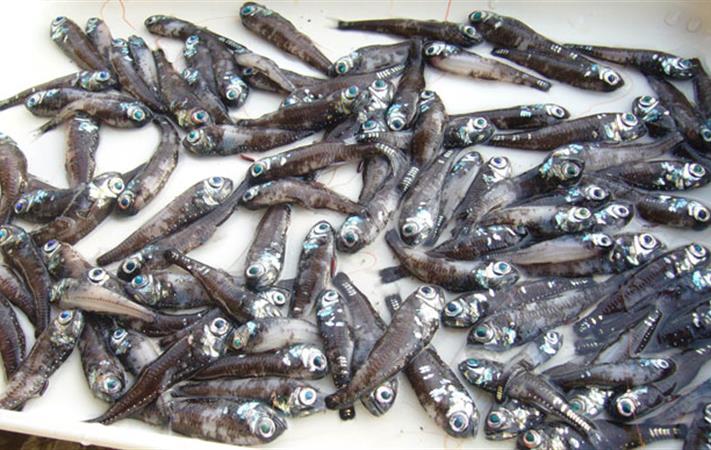Hidden Fish in the Ocean's "Twilight Zone"

There may be a lot more fish in the world's oceans than we thought.
An international team of researchers led by Dr. Xabier Irigoien, Director of the Red Sea Research Center at King Abdullah University of Science and Technology (KAUST), used acoustic readings taken during an around-the-world voyage to revisit old estimates of fish populations living between 200 and 1000 meters depth—a region known as the mesopelagic zone. The team's findings were published in Nature Communications on 07 February 2014, as a paper entitled "Large Mesopelagic Fishes Biomass and Trophic Efficiency in the Open Ocean."
Their results suggest that current estimates of mesopelagic fish quantities are off by an order of magnitude, and that open-ocean ecosystems are as efficient as coastal regions in cycling nutrients up the food chain. Together, these conclusions may assign mesopelagic fish a previously unrecognized role in the world's carbon cycle.
Sometimes referred to as the ocean's "twilight zone," the mesopelagic marks the transition from sunlit surface waters to the black abyss below. Not enough light reaches mesopelagic depths to allow for photosynthesis. But although it's dim, it's anything but empty.
Sneaky fish may skew data
"Up to now it was estimated that there were about 1000 million tonnes of mesopelagic fish," said Irigoien, a number corresponding to roughly half of the total mass of fish previously thought to inhabit the world's oceans. "But this estimation was based on fishing with nets—trawling," he said.
A recent paper by Irigoien's colleague Dr. Stein Kaartvedt, Professor of Marine Sciences at KAUST, demonstrated that mesopelagic fish are adept at dodging nets, and thus deep sea trawling efforts could drastically underestimate true fish populations.
The team's findings support this idea. Using a kind of echo-location to estimate the density of biomass at different depths, they gathered nine months of data from across the world's oceans.
"We found that to have just 1000 million tonnes was almost impossible," Irigoien said. "There must be about ten times more mesopelagic fish on the planet than we previously thought."
Energy- and nutrient-efficient open oceansConventional wisdom in marine science suggests that deep, open ocean ecosystems are less efficient than coastal regions at moving nutrients and energy generated by primary producers—in this case phytoplankton—up to its mid and top-tier predators. But using a computer model paired with the acoustic results, the team's findings suggest the opposite.
"The open ocean is as efficient, if not more, than the coastal seas in terms of its trophic chain," Irigoien said.
Discovering carbon cycles of the deepThe mesopelagic zone is home to a genus of translucent fish called Cyclothone, which generally measure just a few centimeters in length. But what they lack in size, they make up for in number. Even the early, low estimates of mesopelagic biomass make Cyclothone the most abundant vertebrate on Earth.
Like tiny monsters of the deep, legions of mesopelagic fish ascend through the darkness each night to hunt zooplankton drifting in the surface waters of the open ocean. At dawn they descend again to wait out the day, carrying bellies full of organic material—essentially carbon—some 500 meters or more down from the surface.
"By doing that migration," Irigoien said, "they are accelerating the CO2 pump." Given previous mesopelagic biomass estimates, this contribution to global biogeochemical cycles was deemed insignificant, but this thinking may have to be revised. "With the new estimate, we calculate that mesopelagic fish are respiring between one and ten percent of the primary production produced at the surface," he said.
Unfortunately, this abundance of fish doesn't translate directly to an abundance of food for humans. Mesopelagic fish are generally small, fatty, and too deep and dispersed through the world's oceans to be of commercial interest. They are, however, an important part of the diet of the tuna we eat.

